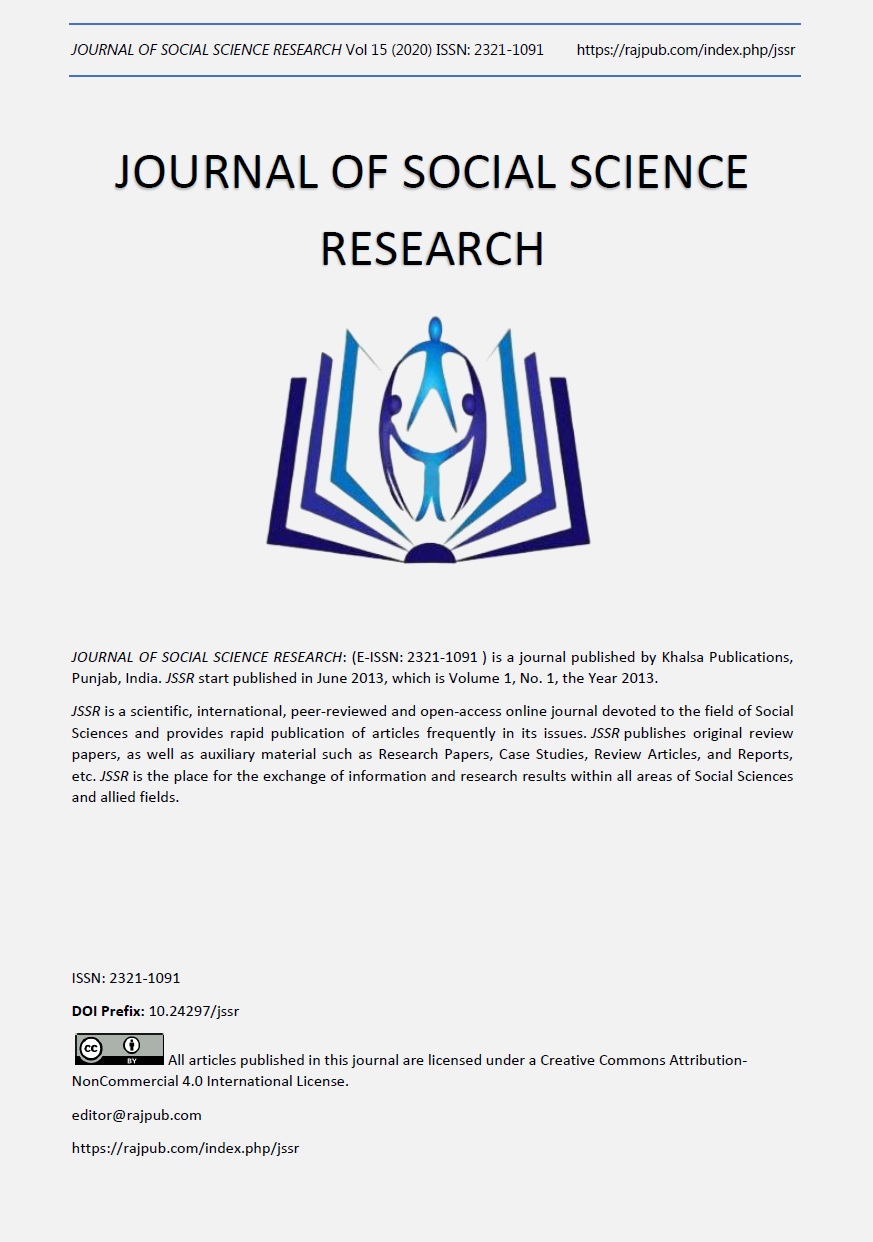Unfamiliarity the Fertile Period Among Childbearing-Aged Women in Côte d'Ivoire: Towards the Demographic Dividend
DOI:
https://doi.org/10.24297/jssr.v15i.8669Keywords:
Unfamiliarity, Fertile Period, Childbearing-Aged Women, Côte d'Ivoire, Demographic DividendAbstract
Most of the studies carried out in the field of fertility ignore the lack of knowledge of the fertile period among women of childbearing age, and those that do exist are biomedical in nature, thus leaving the sociodemographic approach on the shelf. In Côte d'Ivoire, 32% of women have a good knowledge of the fertile period against 68% with questionable knowledge. Yet, knowledge of the fertile period is important for birth control and has benefits such as avoiding drug side effects, immediate recovery of fertility and its being free of charge. This study intends to use secondary data from the 2011-2012 EDS-MICS of Côte d'Ivoire to highlight the extent to which the level of unfamiliarity with the fertile period vary among women of childbearing age and investigate related factors. The findings, based on both bivariate descriptive and multiple component factorial analyses, reveal a correlation between lack of knowledge of the fertile period and variables relating to standard of living, place of residence, religion, exposure to the media, marital status, level of education, use of birth control, and the woman's occupation. Therefore, addressing these variables, would not only help control both fertility, and family planning, but also help achieve the demographic dividend.
Downloads
References
Adon, K. P. (2014). Echec de l’utilisation des produits contraceptifs chez les femmes de deux districts sanitaires
en Côte d’Ivoire. African Population Studies, 28(3), 248-262. http://aps.journals.ac.za
Anoh, A., Fassassi, R. & Vimard, P. (2004). Politique de population et planification familiale en Côte d’Ivoire
In (Gautier A. (director)), Les politiques de planification familiale : Cinq expériences nationales. Paris,
IRD, Centre français sur la Population et le Développement, Laboratoire Population-Environnement-Développement, 195-231.
Akindes, F. (2016). Les grossesses en milieu scolaire en Côte d’Ivoire. Abidjan, Côte d’Ivoire : Ministère de
l’Education Nationale, Projet d’urgence à l’éducation de base. Anonyme, (2018). La planification familiale : une pratique déterminante pour l’atteinte du dividende démographique,https://cotedivoire.unfpa.org/fr/news/la-planification-familiale-une-pratique-d%C3%A9terminante-pour-latteinte-du-dividende-d%C3%A9mographique consulté le 3 janvier 2020
Doumbia, M. (2011). Le Programme National de la Santé de la Reproduction et de Planification Familiale en Côte
d’Ivoire : quel avenir dans un contexte post-crise ? Revue ivoirienne d’anthropologie et de sociologie.
KASA BYA KASA, 19, 112-128
Dionne, E. & Fleuret, C. (2016). L’analyse de données secondaires dans le cadre d’évaluation de programme : regard théorique et expérientiel. Notes sur la recherche et les méthodes. La Revue canadienne
D’évaluation de programme, 31.2 (Fall/automne), 253–261 doi: 10.3138/cjpe.142.000
Gaboury, I., Guignard N. J., Forgues, E. & Bouchard, L. (2009). Les données administratives et d’enquêtes sur
L’état de santé et l’accès aux services des communautés francophones en situation minoritaire : potentiel
D’analyse et état de situation. Ottawa, Consortium national de formation en santé, rapport de recherche.
Grimes D.A., Gallo M.F., Halpern, V., Nanda, K., Schulz, K.F., Lopez, L.M. (2012). Planification familiale au moyen de méthodes basées sur la connaissance de la fécondité, Editorial Group: , Cochrane Fertility Regulation Group, http://www.cochrane.org/fr/CD004860/planification-familiale-au-moyen-de-methodes-basees-sur-la-connaissance-de-la-fecondite, le Consulté 18/10/2016
Henry, L. (1962). Connaissance de la période fertile et fécondité. In: Population, 17ᵉ année, n°3, pp. 549-550; http://www.persee.fr/doc/pop_0032-4663_1962_num_17_3_10182, consulté le 18/10/2016
http://www.onp.gouv.ci/index2.php?page=pre&num=5
Institut National de la Statistique & ICF International. (2012). Enquête Démographique et de Santé et à Indicateurs Multiples de Côte d’Ivoire 2011-2012. Calverton, Maryland, USA : INS et ICF International.
Institut National de la Statistique (INS), 2005. Enquête sur les Indicateurs du sida, Côte d'Ivoire. Calverton,
Maryland, USA : INS et ORC Marco. Institut National de la Statistique & ORC Macro. (2001). Enquête Démographique et de Santé, Côte d’Ivoire 1998-1999. Calverton, Maryland USA : Institut National de la Statistique et ORC Macro.
Johnston, M.P. (2014). Secondary data analysis: A method of which the time has come. Qualitative and
Quantitative Methods in Libraries, 3, 619 - 626.
Ministère du plan et du développement. (2017). La situation des femmes et des enfants en Côte d’Ivoire :
Enquête à indicateurs multiples 2016-MICS.
Abidjan Ministère de la santé et de la lutte contre le sida/Programme National de la santé de la reproduction/
Planification familiale. (2014). Plan d’action national budgétisé de planification familiale Côte d’Ivoire 2015-2020, Abidjan.
OMS. (1997). Profil santé de la femme en Côte d’Ivoire, Abidjan, Bureau OMS. RCI. (2016). Rapport de suivi du PND
Smith, E. (2008). Using secondary data in educational and social research. Berkshire, United Kingdom: Open University Press.
Hargot, T. (xxxx). Fertile ou infertile? L'observation du cycle féminin, http://www.reussirmavie.net/Fertile-ou-infertile-L-observation-du-cycle-feminin_a88.html, consulté le 15/10/2016.
USAID and Transform Phare. (2017). Rapport final Analyse du Marché de Planification Familiale et des Services de Communication pour le Changement Social et Comportemental selon l’Approche du Marché Total. Abidjan.
Victoria H. J., Arevalo, M., Kowal, D. (2007). Méthodes basées sur la connaissance de la fécondité, sous la direction de Robert A. Hatcher, James Trussell, Felicia Stewart, Anita D. Nelson, Willard Cates, Felicia Guest and
Deborah Kowal, Contraceptive Technology, 18th Revised Edition, https://www.k4health.org/sites/default/.../Contraceptive%20Technology%20FRE.pd, consulté le 10/10/2016
Downloads
Published
How to Cite
Issue
Section
License
 All articles published in Journal of Advances in Linguistics are licensed under a Creative Commons Attribution 4.0 International License.
All articles published in Journal of Advances in Linguistics are licensed under a Creative Commons Attribution 4.0 International License.




